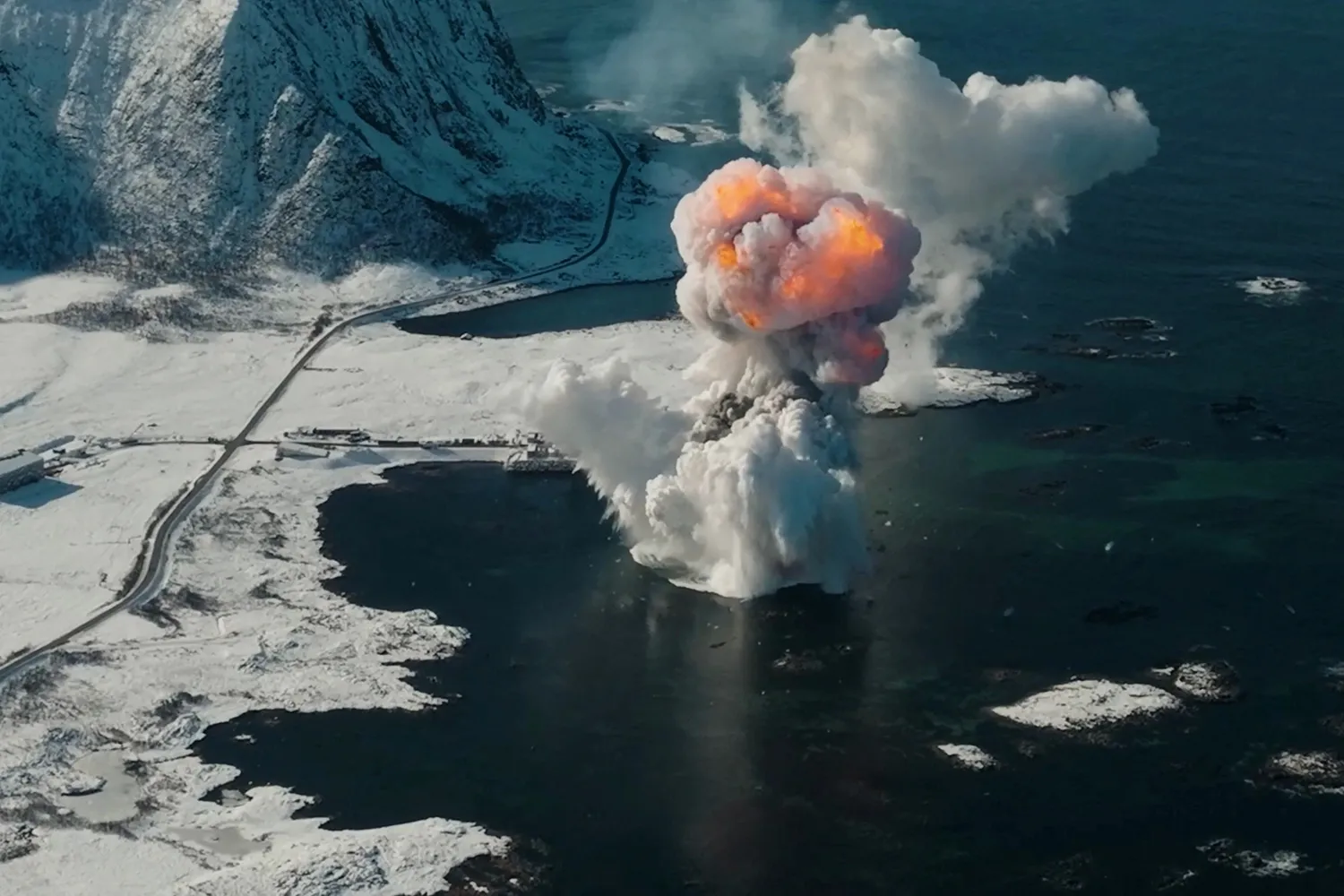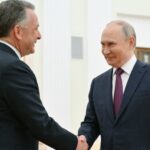Europe’s Failed Mission to Space

Analysis
Europe’s Failed Mission to Space
Without their own space capabilities, Europe’s armed forces are blinded and grounded.
The explosion of the unmanned Spectrum rocket in Andøya, Norway is seen in this image from a video made by Isar Aerospace, on March 30. Handout via REUTERS
On March 30, a German start-up launched a rocket designed to place small satellites into orbit from Europe. Taking off from Norway’s Andøya spaceport above the Arctic Circle, it was the first-ever attempt to reach orbit from anywhere in Europe outside Russia and would have been a milestone in Europe’s goal of gaining independent access to space.
Constructed by Isar Aerospace, the two-stage rocket named Spectrum lasted approximately 40 seconds before exploding. It is, of course, nothing unusual for a new rocket to fail on its first attempt. Nevertheless, the failure reflects broader shortcomings in Europe’s space ambitions that carry strong implications for European strategic autonomy.
On March 30, a German start-up launched a rocket designed to place small satellites into orbit from Europe. Taking off from Norway’s Andøya spaceport above the Arctic Circle, it was the first-ever attempt to reach orbit from anywhere in Europe outside Russia and would have been a milestone in Europe’s goal of gaining independent access to space.
Constructed by Isar Aerospace, the two-stage rocket named Spectrum lasted approximately 40 seconds before exploding. It is, of course, nothing unusual for a new rocket to fail on its first attempt. Nevertheless, the failure reflects broader shortcomings in Europe’s space ambitions that carry strong implications for European strategic autonomy.
Europe’s defense deficiencies go beyond long-dwindled stocks of ammunition, missiles, and components; a fragmented defense industry; and inadequate funding. It simply lacks the platforms and strategic enablers necessary to undertake military operations in a major war. Not only would Europe struggle to provide an independent strategic-level nuclear deterrent without the United States, but the NATO alliance also depends on the United States for certain high-end conventional military platforms, such as aircraft carrier battle groups, missile defense, electronic warfare, strategic airlift, large-scale logistics, and space capabilities. Even though Berlin, London, and Paris can provide manpower and platforms across the land, sea, and air domains, Europe cannot provide the necessary strategic enablers that underpin high-intensity, large-scale, and long-duration joint operations without U.S. support.
European NATO members have largely been comfortable with their dependency on U.S. enablers due to long-standing trust across the Atlantic. However, the second Trump administration has, in only three months, managed to replace this trust with a high degree of uncertainty across Europe about Washington’s future commitments to NATO. Even though U.S. Secretary of State Marco Rubio indicated at the NATO foreign ministers’ meeting in Brussels in early April that the United States remains faithful to the alliance, this is not enough to repair the damage done to Europe’s trust in its traditional partner.
Thus, Europe must now choose between continuing its reliance on a potentially untrustworthy United States for strategic enablers or start addressing how to eliminate this dependency. The European Commission’s “White Paper for European Defence – Readiness 2030,” published in March, is one step in the direction of the latter approach. However, if Europe desires more strategic autonomy, one of the most urgent issues will be to address the continent’s long-standing failure to build independent capabilities in space. There are four major reasons for this particular urgency.
A composite image of exposures taken over 30 minutes shows a satellite-filled sky near 51 degrees north latitude on June 5, 2024.Alan Dyer/ Universal Images Group via Getty Images
First, space has emerged as a crucial enabler for modern warfare, supporting intelligence, surveillance, and reconnaissance (ISR); many kinds of satellite-based communications; and positioning, navigation, and timing (PNT) systems like GPS. High-resolution satellite imagery provides geospatial intelligence for target identification and enhanced battlefield awareness. Satellites also play a critical role in signals intelligence, providing valuable insight into foreign capabilities and operations. Space is simply an indispensable aspect of joint operations in modern warfare.
Second, the space domain is developing rapidly. While fewer than 1,000 active satellites orbited Earth in 2010, that number has now surpassed 9,000, and it is estimated that as many as 60,000 satellites could be in operation by 2030.
Third, the United States has shown willingness to use its space power as a bargaining tool for political gains. Elon Musk’s Starlink satellite system has provided the Ukrainian military with vital connectivity in its defense against the Russian invaders. However, since gaining power, the second Trump administration has used the Starlink monopoly and other satellite resources to put pressure on Kyiv in the ongoing peace negotiations with Washington and Moscow. Previously, Musk exerted a private veto over Ukraine’s use of Starlink over Russian-occupied Crimea. Ukraine’s dependence on Starlink has made it vulnerable to coercion, and Europe has no alternatives to offer.
Fourth, and most important, Europe is nowhere near the ability to replace its dependence on the United States’ world-leading infrastructure of satellites and space-related ground systems. In other words, European NATO allies may find themselves in a similar position of vulnerability as Ukraine if they do not prioritize independent space capabilities.
Staff from China’s Manned Space Agency and visitors watch as the Long March 2F rocket carrying the Shenzhou 16 spacecraft launches in Jiuquan, China, on May 30, 2023.Kevin Frayer/Getty Images
Europe’s space program also falls short when compared to Russia and China. Although Russia is showing signs of shrinking as a space power due to sanctions and economic difficulties, China is building space assets at lightning speed across the whole range of capabilities. In 2023, Chinese government spending on space programs was reportedly twice as large as the combined spending of Britain, France, and Germany.
European states have designed their defense on a pillar of U.S. space support, without developing homegrown alternatives. The only exception is the European Space Agency’s (ESA’s) Galileo system, which stands as an alternative to GPS. In other words, without access to U.S. space capabilities, Europe’s armed forces are both blinded and grounded.
The failed launch at Andøya in northern Norway is only the latest episode in a long history of European stagnation in space. In contrast to the United States, where SpaceX enjoys a monopoly on reusable rocket systems, European launch systems are technologically outdated and consistently delayed. The ESA’s newest rocket, Ariane 6, had its first fully successful launch in March—five years later than scheduled. Last year, Britain’s attempts to launch a rocket into orbit from its new spaceport in Shetland ended in failure after the rocket exploded on the launchpad during a static fire test.
The European Space Agency’s Ariane 6 rocket is seen prior to its maiden launch at the Guiana Space Centre in Kourou, French Guiana, on July 9, 2024.Jody Amiet/AFP via Getty Images
The absence of reliable and predictable launch capabilities is crucial. Even if Europe could hastily put together advanced satellites, the lack of dependable launch infrastructure would make them useless. To put a number on Europe’s failure: Of 672 orbital launch attempts worldwide between 2022 and 2024, only 12 were launched by European operators. Europe’s only proven orbital launch site is not even in Europe, but in the former colony of French Guiana. Indeed, had the Norwegian launch succeeded, it would have been the first from anywhere in Europe outside of Russia.
In terms of satellites, Europe is lagging in every category. Take those in geostationary orbit: Although the Europeans have satellites for weather monitoring, broadcasting, and telecommunications, their pool of military satellites is modest compared to the United States, China, and Russia. Additionally, both China and Russia reportedly have satellites in geostationary orbit that are capable of in-orbit counterspace attacks—in other words, to destroy or damage other countries’ satellites. Europe is also largely dependent on Washington’s space-based early-warning system, which is a major obstacle in Europe’s hopes for a truly independent nuclear deterrent.
Highly elliptical orbit, which is useful for providing continuous coverage over an adversary’s territory, almost completely consists of Russian and U.S. satellites. A notable recent addition is Norway’s Arctic Satellite Broadband Mission, a pair of satellites that may enhance European communications capabilities in the Arctic, a region where connectivity and situational awareness are highly limited. But were it not for U.S. funding, U.S. technological cooperation, and the ability to launch from the United States, that project would never have come to fruition.
The highest number of satellites are in low earth orbit (LEO), and most of them belong to Musk’s Starlink system. Here, too, Europe is underrepresented. The role played by Starlink in Ukraine—and the experience of U.S. restrictions on its satellites’ use—has driven several countries and companies to try to replicate Musk’s system. The European Union’s IRIS2 project envisions a meager 290 satellites—compared to more than 7,000 Starlink units in LEO today. Moreover, the EU project will not start initial operations until 2030. If the speed and scope aren’t dramatically scaled up, it is unrealistic that IRIS2 will become a meaningful addition to European security and autonomy in a relevant time frame.
Ukrainians use their mobile phones next to a Starlink satellite-based broadband station in Kherson, Ukraine, shortly after Ukrainian forces liberated the city from Russian occupation, on Nov. 13, 2022.AFP via Getty Images
Russia, in contrast, is working toward a production capacity of 250 new satellites annually, while China is planning two separate satellite mega-constellations in LEO consisting of more than 10,000 satellites each. The United States, which is increasingly focusing its satellite deployments on LEO, aims to deploy hundreds of new military satellites there over the coming three years.
The falling cost of satellites and launch vehicles has gone hand in hand with a shift of space activities away from state dominance toward the commercial space sector, including SpaceX and Blue Origin in the United States, Skyroot in India, and Galactic Energy in China. While there are a number of European commercial actors in the space segment, they are fragmented and operate on tight profit margins. Indeed, space operations are rarely profitable on a purely commercial basis. Without clearer missions, higher subsidies, and closer cooperation with Brussels, Europe’s commercial space sector will likely remain stagnant.
Europe is evidently nowhere close to being a military space power. Even though initiatives like IRIS2 and Norway’s launch attempt carry some promise, Europe’s space policy fundamentally lacks ambition and coherence. Moreover, it does not appear to have a clear strategy in terms of reducing dependency on U.S. enablers. As European governments rapidly increase their defense budgets, it is still unclear whether any of this new spending is earmarked for the space segment.
The unmanned Spectrum rocket launches in Andøya, Norway, on March 30. It exploded shortly after takeoff.Isar Aerospace/via Reuters
Hammering out its future space policies, Europe needs to carefully consider three overarching aspects.
First, there needs to be a balance between short-term military priorities and long-term investments. As the new EU white paper makes clear, the list of European capability gaps is long—and in contrast to many other military acquisitions, increasing military space power is a long-term project. But it is precisely because it takes time to build the various components of space power—including not only rockets and satellites, but also ground stations, launch sites, and other necessary infrastructure—that Europe needs to urgently and visibly move forward.
Second, Europe needs to form a coherent doctrine that recognizes space as a contested domain that will likely be subject to warfighting in the future. Space will not remain a sanctuary. On the contrary, satellites will be targeted in future conflicts, and Europe must prepare for this through the development of redundant and resilient space capabilities, as well as its own anti-satellite weapons.
Third, even though investing in space capabilities remains expensive, building space power may produce technological spillover effects that benefit other military and commercial activities. The Cold War-era space race, for example, produced several important civil and military innovations, including in computer systems and medical technology. Many military space technologies are inherently dual-use, and prioritizing the space domain may generate significant technological benefits for Europe as a whole.
For Europe to become an autonomous military actor, it needs to rapidly shrink the gap in space capabilities vis-à-vis its competitors. The United States has spent seven decades building a pillar of enablers that hold up NATO’s military might. It is a momentous task for Europe to reduce its dependency on that pillar, let alone replace it. A successful European rocket launch would be the first step on the very long road to military autonomy.
Jo Inge Bekkevold is a senior China fellow at the Norwegian Institute for Defence Studies and a former Norwegian diplomat.
Jonas Vidhammer Berge is a researcher at the Norwegian Institute for Defence Studies, where he specializes in the space domain, cyberweapons, and new technologies.
More from Foreign Policy
-

A drawn illustration of a Trump whirlwind on a red background Four Explanatory Models for Trump’s Chaos
It’s clear that the second Trump administration is aiming for change—not inertia—in U.S. foreign policy.
-

Marco Rubio is seen up close, sitting on a couch beside J.D. Vance. Marco Rubio’s Soulless Crusade
The U.S. secretary of state stands for no principle other than serving the man who appointed him.
-

Soldiers from various NATO allies take part in a military exercise at the Smardan Training Area in Smardan, Romania, on Feb. 19. America Will Miss Europe’s Dependence When It’s Gone
European self-reliance for security will cost U.S. jobs, profits, and influence.
-

A collage photo illustration shows Donald Trump gesturing with arms wide. In front of him are headshots of Benjamin Netanyahu and Vlodymyr Zelensky, images of immigratns and ICE police, a tattered EU flag and America First signs. Trump’s First 100 Days on the Global Stage
Ten thinkers on what to make of the opening salvo of the president’s second term.
















Join the Conversation
Commenting on this and other recent articles is just one benefit of a Foreign Policy subscription.
Already a subscriber?
.
Subscribe
Subscribe
View Comments
Join the Conversation
Join the conversation on this and other recent Foreign Policy articles when you subscribe now.
Subscribe
Subscribe
Not your account?
View Comments
Join the Conversation
Please follow our comment guidelines, stay on topic, and be civil, courteous, and respectful of others’ beliefs.
Change your username |
Log out
Change your username:
CANCEL
Confirm your username to get started.
The default username below has been generated using the first name and last initial on your FP subscriber account. Usernames may be updated at any time and must not contain inappropriate or offensive language.